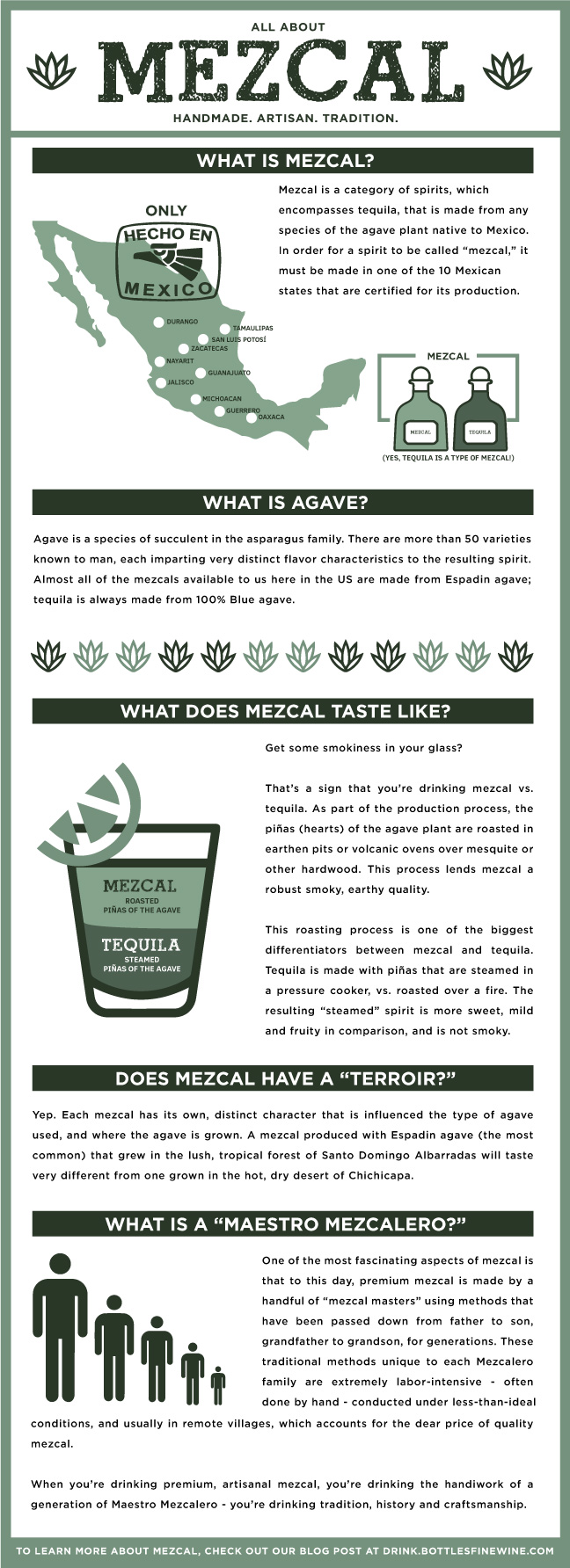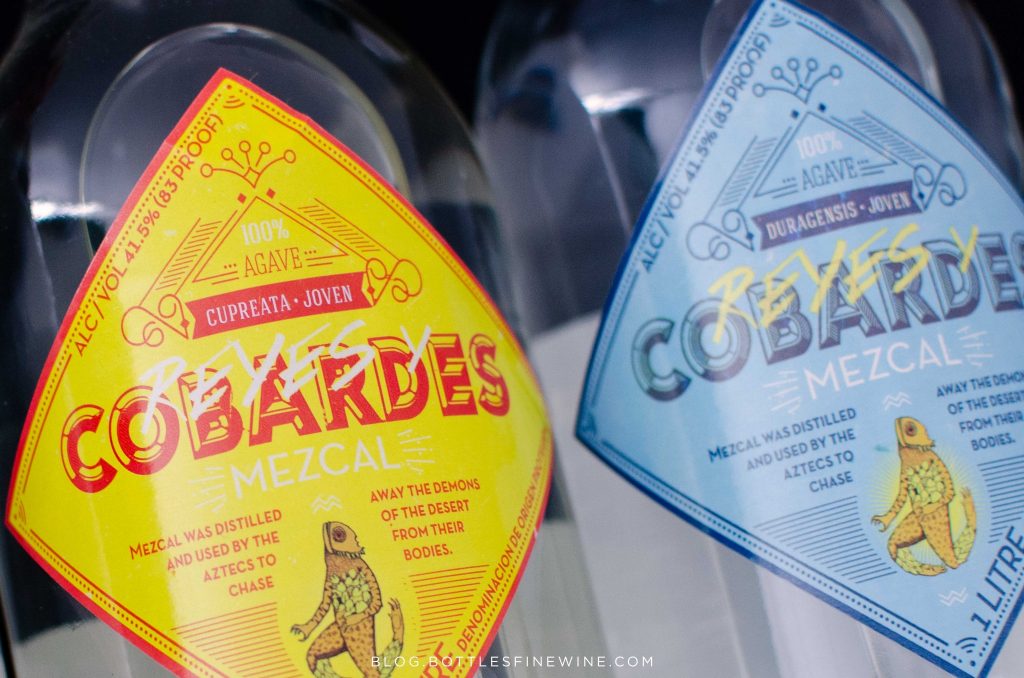At the time of this writing, mezcal is undeniably the hottest spirit amongst true cocktail aficionados. The demand for quality mezcal is growing, specialized mezcal bars are sprouting up in cities around the globe, and more and more premium brands making their way to our shores from Mexico. Yet there’s still a fair amount of confusion around what mezcal is, and why it is costs so much.
Simply put: Good mezcal ain’t cheap, and cheap mezcal ain’t good. Read on to find out what mezcal is, and why the good stuff is absolutely worth exploring and enjoying.

What is mezcal and how does it differ from tequila?
Mezcal is a category of spirits made from a distillate of fermented agave that comes from any of the 10 Mexican states listed above.
Mexico’s more famous spirit, tequila, is a type of mezcal that can be made only in the five states of Nayarit, Tamaulipas, Guanajuato, Michoacán, and Jalisco. That said, 90+% of all tequila comes from Jalisco.
Different species of agave, climates, production methods, and other factors all contribute to the myriad differences between between individual mezcals and between tequila and mezcal, but very simply put:
- tequila can ONLY be made from the “Blue” agave (agave tequilana).
- the piñas (the harvested heart of the agave plant – it looks like a pineapple) used in tequila production are pressure cooked inside a giant industrial oven and often distilled in larger industrial-scale stills with large production capability.
- mezcal, on the other hand, can be made from any of the 50+ known species of agave, including “Blue,” although 90+% of all mezcal is made from Espadín (agave angustifolia).
- piñas for mezcal are most often cooked in earthen pits (less often in rustic brick ovens) over mesquite or other hardwood. In some instances, these ovens are lined with volcanic rock or some vegetation to separate the piñas from the fire.
- mezcals are distilled in extremely small clay or earthen stills, sometimes copper, often with rudimentary cooling and filtration systems.
In terms of how these production differences translate into flavor, you’ll find that steamed, or pressure-cooked tequila is usually a sweeter, mild, and fruity spirit, while the roasted, baked mezcal is much more robust: smoky, earthy, vegetal, and herbal.
What is agave?
Agave is a species of succulent in the asparagus family. A remarkable plant that can thrive in low moisture areas, its use is intrinsically tied to the history of the regions in which it grows. It is an extremely useful plant with edible leaves, flowers, stems, and sap. It has a fibrous core and stiff leaves that are used to make pens, rope, clothing, baskets, musical instruments – the list goes on. Agave grows wild, abundant, and reliably in Mexico, so it became a natural source for spirit production, as opposed to labor-intensive grains or grapes.
Agave comes in many different shapes and sizes. Some are very large, growing up to 10’ tall and weighing a hundred pounds when harvested, while others grow more like shrubs, and will weigh 5-10 pounds at harvest. Each agave has its own unique life-cycle. Some mature in 5-8 years, others in 7-10 years, still others in 20 years or more. Each agave flowers once, and then dies. This is its natural life-cycle. The cortadors (farmers who cut a harvest agave for the mezcaleros) decide when to arrest this flowering to allow the agave to fill with nectar before harvesting and roasting.
And just like wine grapes, each agave has its own unique flavor characteristics, much like a pinot noir is distinct from a cabernet sauvignon, or a malbec, or a zinfandel, etc., that is influenced by its climate and soil. A sauvignon blanc from France’s Loire Valley will taste very different from the same grape grown in California. In the same way, a mezcal produced from the same Espadín variety will taste very different when grown in the hot, dry desert of Chichicapa as opposed to one made in the lush, tropical forest of Santo Domingo Albarradas.
Why the high price tag?
Quality mezcals are, quite literally, handmade, artisanal products. “Artisanal” is a much overused word in today’s marketing canon, and its meaning has become muddied through repeated use. It bears reminding what “artisanal” means.
According to Miriam-Webster, “artisanal” is defined as:
1: of, relating to, or characteristic of an artisan
2: produced in limited quantities by an artisan through the use of traditional methods
So unlike mass-produced foods easily found in your grocer’s freezer section and the large chain fast-food restaurants who claim to sell “artisanal” products, premium mezcal is absolutely, wholly artisanal. It is made in small batches by a handful of people in an extremely labor-intensive processes under less-than-ideal conditions in the same method that it’s been produced for hundreds of years. Where the cuts on the agave are made, how the pits are dug, how long the agave is roasted, what wood is used to fuel the oven, the temperature at which it’s distilled – all these decisions and many more have been passed down from father to son, grandfather to grandson for generations.
Furthermore, most of the villages where mezcal production takes place are in remote locations, and the agave that is used is often grown dozens if not hundreds of miles away from the village. When you take into account the amount of time it takes for an agave plant to mature, then to be harvested at just the right time, transported to a palenque (the cool name for a mezcal distillery), roasted and tended by hand (the cooking process can sometimes take weeks to complete), mashed either by a giant stone (called a tahona) pulled in a circle by a horse or, more commonly, beaten into a pulp by hand, then distilled twice in super small batches – you can see where the time and effort add up. And we still haven’t gotten the finished spirit bottled, tested and approved by the mezcal authorities (yes, every batch is tested for proof and quality before it can be released), and then transported north to the United States, where tax must be paid…it all adds up.
A good mezcal is going to run you about $35-$40 dollars (note, not a bad mezcal, not a stupendous mezcal, but a solid bottle). For a superior mezcal, you’re looking at closer to $50-$70. And a rare, extraordinary mezcal is going to run you $80 – $100+. (Cheap mezcal is the one with the worm in it and is garbage – we’re not talking about those here.)
A final consideration in expense, and an important one, is the agave used to make the mezcal. As mentioned earlier, most mezcals are made from Espadín. This is because Espadín matures relatively quickly (5-7 years) and has a hefty yield. A single Espadín piña will make about 15 liters of finished spirit. A mezcal made from the small, wild-growing Tobala agave is going to be much more expensive. Tobala takes closer to 25 years to mature, and each piña yields a mere liter. Due to it’s small size and concentration of flavors, Tobala is often referred to as the ‘King of Agave’ because the Mezcals it produces are so darned tasty.
Is Tobala better than Espadín? Is Espadín from southern Oaxaca better than an Espadín made in San Luis Potosi? No! They are merely different, and just like anything else, people like what they like. That doesn’t make them wrong or right, better or worse. Tobala is more expensive because it’s harder to find and produces smaller quantities, but that doesn’t preclude that any mezcal made from Espadín is inferior in any way.
To help you on your road to discovery, we’ll be featuring a variety of mezcals at all price points. This week, we start with the unique and delightful Reyes y Cobardes mezcals, which can give you a sense of the variances in flavor that different regions and agaves can give you.

Their “Cupreata” is made by Don Rafael Cuenca, a fourth-generation mezcalero in Zitlala, Guerrero. It’s an easy and welcoming mezcal, with sweet flavors of lemon, citrus and vanilla, under a soft smoky blanket. At a relatively low 83°, it’s an excellent entryway into the world of mezcal, equally suited to sipping or mixing in a cocktail.
$34.99 (IL) through April 30th. Regularly $39.99
The Reyes y Cobardes “Duragnesis” is made by Don Jorge Garcia, a third generation mezcalero who harvests his own agave off the banks of the river on his family farm in a town with a mere 140 residents. This is an unusual mezcal, with characteristics of wet earth, a touch of funk and a cheesy-aroma which is typical of the Cenizo agave plant. It’s a great starter mezcal, especially if you’re looking to experiment with savory/smoky cocktails.
$34.99 (IL) through April 30th. Regularly $39.99
Tune in next week when we present more of our expanding mezcal selection. And if you want to geek out with us even more, stop in the store anytime to talk with our team members who’ve been bitten by the mezcal bug.
Wherever your exploration takes you, we hope you’re able to try this extraordinary spirit and find something to love. Many who develop a taste for mezcal never look back, and they never drink tequila again!
# # #
prices subject to change
